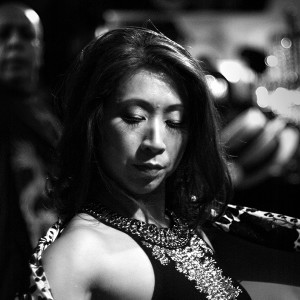Glossary of Flamenco Terms
Discussion & Exploration of Letra
By Kasandra “La China”
April 6, 2008
Inspired by my Bulerias Por Fiesta class on Thursdays
I realize that there is a lot of flamenco jargon I use in regular life sentences. I am beginning to get a sense that I am not speaking like a normal person. I am speaking Flamenquese. Other flamencos get me, normal people don’t. But because I’ve been immersed in this flamenco world for such a long time, I simply naively believe that everyone understands what I am talking about.
There’s music jargon, dance jargon, Spanish jargon…that’s a lot of jargon. I use all this terminology on a regular basis but it dawned on me the other night in my Bulerias class that my students are hearing me like Charlie Brown and Peppermint Patty hear their school teacher, something like this, “Mogh-mogh mo-mogh Coletilla, MOOgh, Letra, mogh MOoogh Letra!”. Student raises hand and quietly begs the question, “What is a letra?” Kasandra does a double take and thinks, okayyyyy. I had a bit of a breakdown after this and was going, I must be making some terrible assumptions about what my class knows about flamenco. Bad teacher, bad teacher!
So here’s a glossary of terminology inspired by my Bulerias class. It’s relevant for all classes. Hopefully this will go a long way to understanding my flamenquese.
Por Fiesta Structure
| For the Dancer | For the Musician |
|---|---|
| Entrada | First Letra |
| Letra | Second Letra |
| Desplante | |
| Salida | Coletilla |
Por Fiesta Jargon
In the world of Bulerias and Tangos por Fiesta, my jargon remains consistent. Here’s a list:
Entrada – Entrance. This could be the musicians’ entrance or the dancer’s entrance. If starting a new song, the guitar has his own entrance (some strumming then a falsetta melody), the singer has his/her own entrance (an AIYEEE) and then each dancer makes an entrance, as they do their solos.
Salida – Entrance or Exit. In Flamenco, one does not really differentiate between entrance versus exit. In Spain, they use the term Salida for both. However, since we are Canadian and have to be organized, for our purposes, we will say the Salida is the exit. This is when the dancer does a final llamada and walks off the stage.
Letra – A letra is a verse of song. In Por Fiesta, the dancer usually enters as the singer is singing a letra, in the middle of the letra. There are lots of different letras out there but typically there are some letras intended for dancing. A singer can “call” the dancer onto the stage by singing a certain letra. For instance, for Bulerias, there are standard letras used to call the dancer; for Tangos, Tango de Granada is a good one to call a dancer on or they can use a coletilla.
Coletilla – Little Tail. That is the literal translation. The practical translation is that is a little final song to end the section, end the song or end the dance. It is sung as the dancer is doing a Salida. Conversely, it can be sometimes used to call the dancer onto the stage and do an Entrada as well. Again, there are lots of different coletillas.
Marcaje – To Mark. These are simple marking steps used by the dancer to mark the compas and mark the time. They are complimentary to the music.
Remate – To Finish. Also known as a break or cierre. They are punctuations that dancers make to enhance the music and end musical phrases. Remates are typically one bar of music (8 beats in tangos or 12 beats in bulerias, or the last 6 beats in bulerias). They are answers to a singer’s first line in a letra, or they are ends of musical phrases in a letra or coletilla. Guitarists have to do remates too to finish off their falsettas or chord progressions; whatever they start, has to finish off with a remate. To me remates and llamadas are very similar, like brother and sister. Remates are generally one bar of music, whereas llamadas are at least two bars of music, maybe three, maybe four, maybe longer.
Llamada – To Call. Pronounced yamada. Llamadas are rhythmic, so they are used to by dancers to communicate with musicians. Dancers do llamadas for multiple purposes.
a. The dancer can do a llamada as an Entrada to announce that he/she is going to start dancing now.
b. After the singer finishes a letra, the dancer can do a llamada to announce that he/she is doing a Desplante.
c. The dancer can also do a llamada to demand that musicians to start playing a Coletilla and signify that a Salida is forthcoming.
d. Further, a llamada can do a similar job to a Remate by enhancing the music and ending musical phrases within the letra. In this regard, they do the same job as remates but the main difference is that llamadas have to be at least 2 bars long. Remates are only 1 bar long.
Desplante – To Display. The desplante is a short section where the dancer shows off. In Por Fiesta, this is after the singer’s second letra. This could be an extended llamada, eg: 3-4 bar llamada. Or it can be a bit of a footwork section. I guess it depends on the palo you are dancing and context of the situation.
In Bulerias de Jerez, a 3 bar llamada is typical and a 4 bar llamada is pushing it but could be acceptable on a case by case basis. FYI: There is NO escobilla in Bulerias por Fiesta aka Bulerias de Jerez. If you went to Jerez and did a huge footwork section in your bulerias, they would stop you cold, stare you in the eye and ask if you learned flamenco in an “academia”. Haha! This has happened to me, that’s why I mention it. In Jerez, less is more. Don’t overstay your welcome, just keep it simple and short. You’ll be good.
In Tangos por Fiesta, however, a 4 bar or 8 bar escobilla is typically done and is generally acceptable. You would end this off with a llamada or remate to signal your Salida/Coletilla. Anybody who does more than 8 bars is doing some major choreography and I would say it ceases to be in a “por fiesta” style. In any case, my feeling is that a dancer should be able to say what he/she wants to say in 8 bars of music and finish of their rhythmic ideas in a neat package. Otherwise it’s footwork diarrhea, worse than run-on sentences.
Discussion and Exploration of Letra
To me the art of flamenco is really the improvisation of the dance as it relates to the letra. If a dancer knows some simple marcaje, a few remates and a few llamadas, it is entirely possible to improvise the dance. I have taught this to rank beginners after 1-2 months.
Bulerias Example
This is an example of a Basic Bulerias Letra Structure/Melody below. Each line represents 12 beats/1 bar of music. I could do a lot of things here but here is an example of what I could dance. On the other hand, one need not do any of these things and simply mark the whole thing.
| Sample 1 | Sample 2 | Sample 3 | |
| Canta me por bulerias | |||
| Remate | Remate | Remate | |
| Canta me por bulerias | |||
| Que el cante mas gitano | Llamada | ||
| Que tiene mi Andalucia | Remate | ||
| Que el cante mas gitano | Llamada | Llamada | |
| Que tiene mi Andalucia | Remate |
Tangos Example
This is an example of a Basic Tangos Letra Structure/Melody below. Each line represents 8 beats/1 bar of music. Again, I could do a lot of things here, but you’ll see that this example is similar to above. The only difference being tangos versus bulerias. Again, I should point out that I don’t have to do any of these items. I could do marcaje the whole letra and that would
| Sample 1 | Sample 2 | Sample 3 | |
| Triana, Triana | |||
| Que bonita esta Triana | |||
| Remate | Remate | Remate | |
| Que bonita esta Triana | |||
| Que bonita esta Triana | |||
| Cuando le ponen al puente | Llamada | ||
| La banderita gitana | Remate | ||
| Cuando le ponen al puente | Llamada | Llamada | |
| La banderita gitana | Remate |
About The Author
 Kasandra “La China”
Kasandra “La China”
Flamenco Dancer and Instructor, Director, Producer, Choreographer
Kasandra is one of Canada’s leading flamenco artists well-known for her unrelenting drive to push the artistic envelope. A tirelessly ambitious artistic director, soloist and prima bailaora, Kasandra is always hungry for new sources of inspiration and knowledge, constantly pushing her musical and choreographic mastery to its limits. She has been identified as “Vancouver’s flamenco star who has embodied flamenco with her dynamic, precise style” by Flamenco-World magazine. Read More



